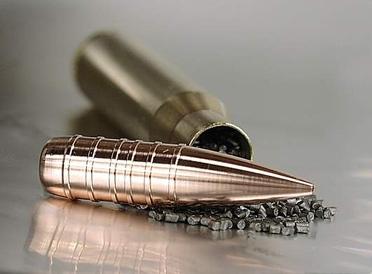

 The Accurate Reloading Forums
The Accurate Reloading Forums  THE ACCURATE RELOADING.COM FORUMS
THE ACCURATE RELOADING.COM FORUMS  Guns, Politics, Gunsmithing & Reloading
Guns, Politics, Gunsmithing & Reloading  Bullet Making
Bullet Making  Turning brass for 0.510 bore, hardness, diameter?
Turning brass for 0.510 bore, hardness, diameter?Go  | New  | Find  | Notify  | Tools  | Reply  |  |
| One of Us |
I was thinking about making my own 0.510 bullets to try in a wildcat (I've been shooting surplus BMG tips so far, and thought I'd try something lighter). Does anyone know if normal half-hard brass can be used? Should it be annealed, or is it ok to leave it hard. Also, what diameter should I use? Should I leave it full .510, or maybe go .508 instead. I've seen some of the turned solids on gun broker, does anyone know what hardness/diameter those are? Thanks. | ||
|
| One of Us |
When you say brass you are probably refering to C360 Free Machining alloy. Many bullets have been made from this alloy, and temper is really not extremely critical. .50 BMG bullets have been made from anything from copper, to bronze, to mild steel. Using an annealed alloy may in fact raise pressure rather than lower it. The soft bullet may obturate too much and swage itself tightly to the bore increasing friction. Most bullets are typically +/-.0005 from nominal groove diameter which is listed as .509 for the .50 BMG. Land diameter is listed as .500 hence the .50 caliber designation. I would suggest a bore rider design or a banded design to minimize the bearing area, and reduce pressure. | |||
|
| One of Us |
Thanks for the reply. I turned a few small bullets and just used a corner rounder to cut the ogive. The material was some brass scrap of unknown alloy and hardness. They shot just fine, were much faster than the BMG bullets due to being half the weight, and very accurate. Even though I was working up the powder with each shot I still had a one hole group at 100m. If I try some heavier versions, with more bearing surface, I'll cut a few grooves as you suggest. Here are some I saw on gunbroker, and I was wondering what material, hardness, and dimensions they used. Maybe I should just buy some and measure:  | |||
|
| One of Us |
Here's a picture of my simple turned bullets:  | |||
|
| One of Us |
I've turned out quite a few .458" size for my 45 cals...and a few .510" for my Rigby based shooter...boat tails, flat base, cup points, HP's, flat points, long and short ogive pointy ones etc. Some with many small grooves(I ground a couple different bits to 0.040" - 0.060" wide with and without a radius) and some with only 3 driving bands(front, middle and base)of different band widths and different groove widths. My fav is a 300 gr, 45 cal, multi groove, 6 - 0.050 bands, 6 - 0.050" grooves, bore rider, 1.5" long, 0.300" long, 30°truncated cone nose with a hollow point 0.225" deep, 0.225" wide cut with a #3 center drill. At 2500 fs it is on the edge of stability for a 22" twist. Basically a FMJ on light skin game, tho'. Just let your mind get wild and wooly. Lots of good examples on various web links...just search for brass bullets. Only problem was getting the length and weight right...you still have to calculate for the twist rate of you caliber and velocity. Just about ANY CNC shop can turn you out all you can afford. One shop in my area will do runs of 100 for $75 plus material cost...$75 for the code work unless I supply it...for 45 cals...roughly $1 - $1.25 a bullet. 50 cal run more because the 9/16 brass costs more. But once I get a design worked out to maximize/minimize machine setup and movements, I can turn a bullet in less than 2 minutes on my cheapo manual lathe. I use C360 brass, usually the cheapest in my area or can be purchased online through several places...I get quite a bit of various small quantity metals through OnLineMetals. Have fun. | |||
|
| Moderator |
try for 1.5e, and everything but bearing surfaces to be slightly smaller than bore opinions vary band of bubbas and STC hunting Club Words aren't Murder - Political assassination is MURDER Information on Ammoguide about the416AR, 458AR, 470AR, 500AR What is an AR round? Case Drawings 416-458-470AR and 500AR. 476AR, http://www.weaponsmith.com | |||
|
| Powered by Social Strata |
| Please Wait. Your request is being processed... |
|
 The Accurate Reloading Forums
The Accurate Reloading Forums  THE ACCURATE RELOADING.COM FORUMS
THE ACCURATE RELOADING.COM FORUMS  Guns, Politics, Gunsmithing & Reloading
Guns, Politics, Gunsmithing & Reloading  Bullet Making
Bullet Making  Turning brass for 0.510 bore, hardness, diameter?
Turning brass for 0.510 bore, hardness, diameter?

Visit our on-line store for AR Memorabilia

